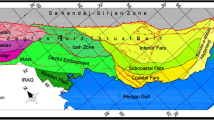Abstract
Research on petroleum structures necessitates the investigation of reservoir rock fractures during field production and development phases and the use of software specifically designed for reservoirs. The present research aims to systematically investigate fractures in the Asmari reservoir, how these fractures develop using FMS and FMI image logs, and the effect of these fractures on the porosity and permeability of these reservoirs. The results indicate the viability of these logs as tools for detecting fractures and structural reservoir dips where water-based drilling mud is used. The present research incorporates the results obtained from FMI interpretations of two wells in the field under study for comparison. In general, production in the Asmari reservoir relies on a combination of fractures and rock matrices. Fractures and porous zones have a substantial effect on the properties of the reservoir rock. Also, two general patterns of tectonic fractures from longitudinal and oblique folding, as well as various other fractures arising from faulting, can be observed in this reservoir. Of these folds, the longitudinal pattern is the most frequent, as it forms the most open fractures extending to N35–65 W. These fractures are primarily observed in the Asmari higher zones (particularly Zone 1).







Similar content being viewed by others
References
Ahmadhadi F, Lacombe O, Daniel J (2007) Early reactivation of basement faults in Central Zagros (SW Iran): evidence from pre-folding fracture populations in Asmari formation and lower tertiary paleogeography. In: Lacombe O, Roure F, Lavé J, Vergés J (eds) Thrust belts and foreland basins SE-11. Springer, Berlin, Heidelberg, pp 205–228. https://doi.org/10.1007/978-3-540-69426-7_11
Alavi M (2007) Structures of the Zagros fold-thrust belt in Iran. Am J Sci 307(9):1064–1095. https://doi.org/10.2475/09.2007.02
Fossen H (2010) Structural geology. Cambridge University Press, Cambridge, p 463
Gholipour AM (1998) Patterns and structural positions of productive fractures in the Asmari Reservoirs, Southwest Iran. J Can Pet Technol 37(1):44–50. https://doi.org/10.2118/98-01-07
Khoshbakht F, Memarian H, Mohammadnia M (2009) Comparison of Asmari, Pabdeh and Gurpi formation’s fractures. J Petrol Sci Eng 67(1–2):65–74. https://doi.org/10.1016/j.petrol.2009.02.011
Martinez LP, Hughs GR, Wiggins ML (2002) Identification and characterization of naturally fractured reservoirs using conventional well logs. The University of Oklahoma
McQuillan H (1973) Small-scale fracture density in Asmari formation of southwest Iran and its relation to bed thickness and structural setting. AAPG Bull 57:2367–2385
McQuillan (1974), Fracture patterns on Kuh-e Asmari Anticline, Southwest Iran. AAPG Bull 58(2), 236–246. http://aapgbull.geoscienceworld.org/content/58/2/236.abstract
Mohebbi A, Haghighi M, Sahimi M (2007) Conventional logs for fracture detection and characterization in one of the Iranian field. In: International Petroleum Technology Conference, 4–6 December, 2007, Dubai, U.A.E. Dubai: International Petroleum Technology Conference. https://doi.org/10.2523/11186-MS
Motiei H (1995) Petroleum Geology of Zagros, Geological Survey of Iran with cooperation of Deputy Ministry of project and planning, No. 25, p 1010
Nelson RA (2001) Geologic analysis of nayurally fracture reservior: integeration is the key of optimazation, distinguished author Series, pp 52–54, SPE 56010
Nie X, Zou C, Pan L, Huang Z, Liu D (2013) Fracture analysis and determination of in-situ stress direction from resistivity and acoustic image logs and core data in the Wenchuan Earthquake Fault Scientific Drilling Borehole-2 (50–1370m). Tectonophysics 2013(593):161–171. https://doi.org/10.1016/j.tecto.2013.03.005
Rajabi M, Sherkati S, Bohloli B, Tingay M (2010) Subsurface fracture analysis and determination of in-situ stress direction using FMI logs: An example from the Santonian carbonates (Ilam Formation) in the Abadan Plain, Iran. Tectonophysics 492(1–4):192–200. https://doi.org/10.1016/j.tecto.2010.06.014
Rezaie M, Chehrazi A (2006) Principles of Surveying and interpreting well logging profiles. Tehran University Press, Tehran
Rezaie AH, Nogole-Sadat MA (2004) Fracture modeling in Asmari Reservoir of Rag-e Sefied oil-field by using multiwell image log (FMS/FMI). Iran Int J Sci 5(1):107–121
Roehl PO, Choquette PW (1985) Carbonate petroleum reservoirs. Springer, Berlin, p 622. http://books.google.com/books?id=SnohAAAAMAAJ
Saedi Gh (2009) An analysis of fractures of the Asmari reservoir of Lali Oil Field using FMI imager logs, A Master’s Dissertation, Geology, Petroleum Engineering, Shahid Chamran University of Ahvaz
Schlumberger (1994) FMI Fullbore Formation MicroImager. Houston: Schlumberger Educational Services
Schlumberger (2003) Using borehole imagery to reveal key reservoir features. In: Reservoir Optimization Conference. Tehran, Iran
Schlumberger (2005) GeoFrame 4.2, BorView User’s Guide. Schlumberger Ltd
Serra O, Serra L (2004) Well logging: data acquisition and applications (p 674). Editions Technip. http://books.google.com/books?id=iAacQAAACAAJ
Serra O (1998) Formation MicroScanner image interpretation. Schlumberger Educational Services, p 117. http://books.google.com/books?id=G_U9twAACAAJ
Tabatabaei H (2018) 3D Modeling in porosity Sarvak formation via Gaussian simulation method in Dezful embayment. A case study. Petrol Coal 60(6):1187–1192
Tabatabaei H, Motamed A, Solimani B, Kamali MR (2012) Geochemistry of Gurpi-Pabdeh–Asmari formation and its Implication on chemical variation during deposition of Pabdeh formation, Zagros Basin. Himal Geol 33:128–136
Thompson LB (2000) Fractured reservoirs: integration is the key to optimization. J Petrol Technol 52(2):52–54. https://doi.org/10.2118/56010-JPT
Tingay M, Reinecker J, Müller B (2008) Borehole breakout and drilling-induced fracture analysis from image logs. World Stress Map Project. www.world-stress-map.org
Wily J, Habibi F (1978) Rag-e-Sefied Field, Asmari formation, Non-Layer reservoir and Zonation” OSCO 1978, Ahwaz-Iran (Internal Report)
Acknowledgements
The authors would like to thank Islamic Azad University of Shiraz for their support.
Author information
Authors and Affiliations
Corresponding author
Additional information
Publisher's Note
Springer Nature remains neutral with regard to jurisdictional claims in published maps and institutional affiliations.
Rights and permissions
About this article
Cite this article
Seyed, S.A., Yazdjerdi, K., Asadi, A. et al. Image log analysis of Asmari reservoir fractures in a Southwest Iranian oil field. Carbonates Evaporites 37, 5 (2022). https://doi.org/10.1007/s13146-021-00747-0
Accepted:
Published:
DOI: https://doi.org/10.1007/s13146-021-00747-0




